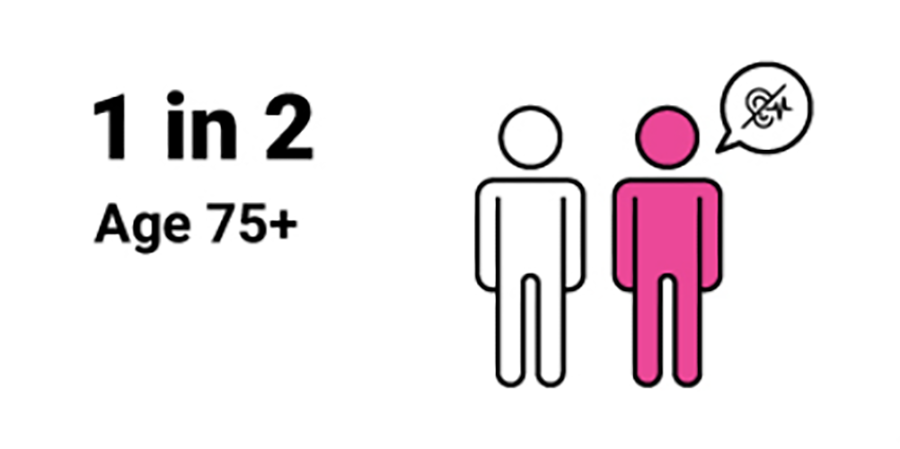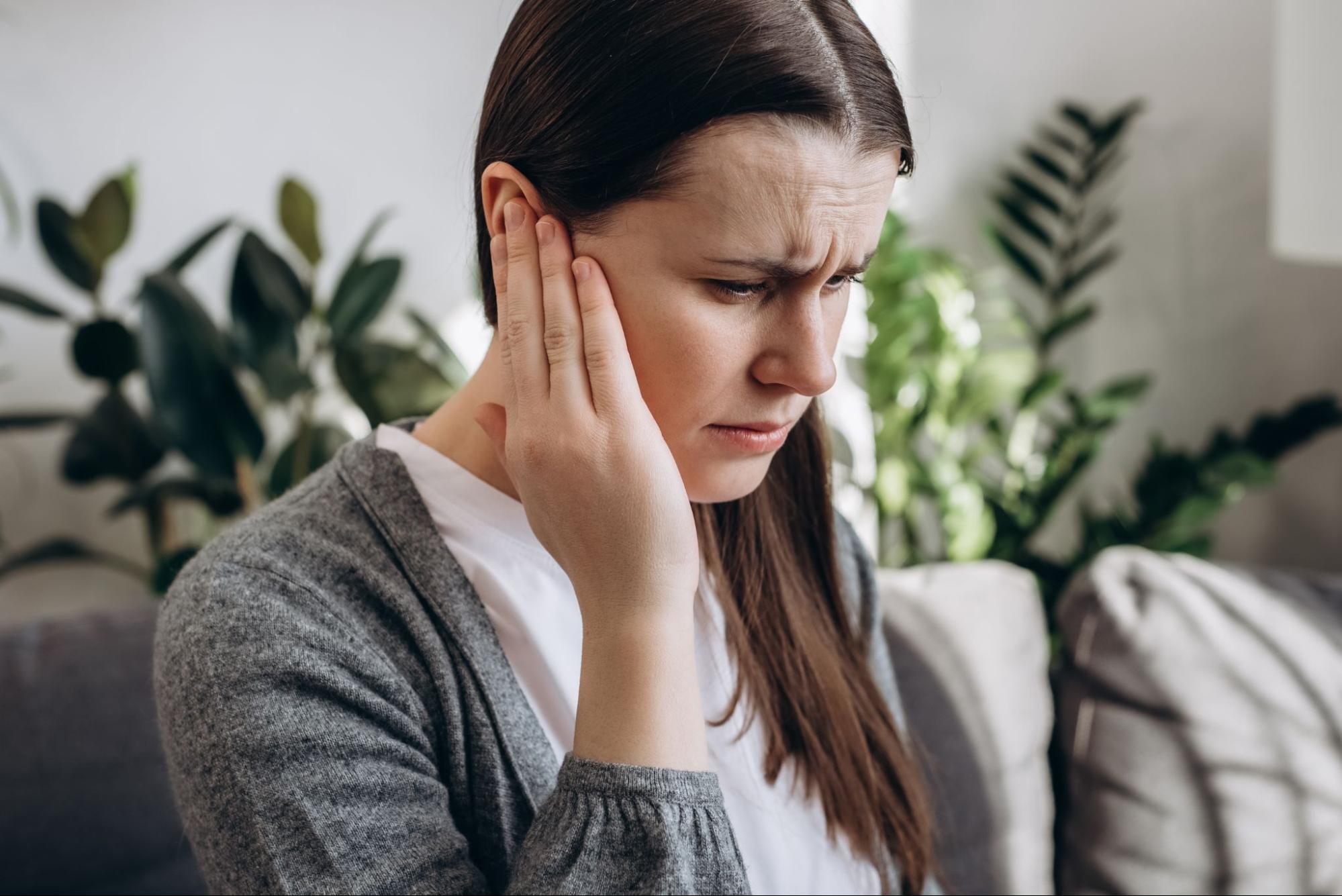Average Hearing Loss by Age
This breakdown of the average hearing loss by age reveals how hearing thresholds change over time as well as understanding how people experience hearing changes.

Hearing changes are a normal part of aging, but the average hearing loss by age varies widely across the lifespan. From infants born with detectable hearing problems to adults in their 40s noticing early high-frequency decline, each stage of life carries different risks and patterns.
By the time people reach their 60s and 70s, hearing loss becomes far more common, and by age 75, about half of American adults experience hearing thresholds that can significantly affect communication and quality of life, particularly among those who grew up hearing and lose hearing later in life.
Here’s a breakdown of the average hearing loss by age:
At Nagish, we’ve gathered statistics that reveal the average age for hearing loss and how thresholds shift over time. If you or someone you care about is navigating hearing difficulties, Nagish’s phone call captioning app can improve communication and help them stay connected.
Average Hearing Loss by Age - Key Statistics
1. One-third of adults aged 65-74 have measurable hearing loss (source)

About 33% of adults develop hearing loss by their early 70s, according to the National Institute on Deafness and Other Communication Disorders (NIDCD). An Australian study found that prevalence rises steeply with age, affecting 70% of adults over 70 and nearly 80% of those in their 80s.
2. Half of adults over 75 experience hearing thresholds that significantly affect everyday communication if unmanaged (source)

Roughly 50% of adults over 75 live with hearing thresholds that can interfere with everyday communication and reduce quality of life if unmanaged or developed later in life. This typically corresponds to a hearing threshold above 40 dB HL, often requiring hearing aids or other interventions to manage.
3. Hearing loss becomes noticeable for most people after age 40 (source)

What is the average age for hearing loss? Generally, people hear well into their 30s, averaging just 10-15 decibels of hearing loss (dB HL). But once people reach their 40s, hearing—especially at higher pitches like 2000 Hz and above—starts to decline more quickly. The drop becomes steeper with each passing decade, especially at 4000 and 8000 Hz.
Additional Statistics on the Average Age of Hearing Loss
1. From middle age onward, men lose hearing faster than women (source)
Men show steeper losses than women, especially at 2000 and 4000 Hz, starting in middle age. By age 80 and older, men often reach 50-70 dB HL at these frequencies, while women generally have a lower average hearing loss by age, with the gap only narrowing in their late 80s and 90s.
2. About 14% of U.S. adults ages 20-69 have difficulty with normal speech frequencies (source)
Hearing loss statistics reveal that in America, nearly 1 in 7 adults between ages 20 and 69 have trouble hearing normal speech frequencies. While some of this is due to noise exposure and other risk factors, much of it reflects the early onset of presbycusis, or age-related hearing loss.
3. Nearly 4 in 10 adults in their 60s have trouble hearing speech sounds (source)
Prevalence rises steeply with age. Among adults aged 60–69, 39.3% experience measurable difficulty hearing speech, particularly in environments with background noise. This marks a turning point where hearing loss can begin to significantly affect daily communication and quality of life for people who previously had no difficulty hearing.
4. High-pitched sounds are hardest to hear with age, especially after age 90 (source)
The sharpest losses occur with very high-pitched sounds, around 8000 hertz. By the oldest age groups, men and women both show severe declines, often with equal ability for high-frequency hearing. By age 90 and older, high-frequency thresholds average above 60 decibels, and even lower-pitched sounds often require 30-40 decibels more volume to hear clearly.
5. Up to .03% of children are born with hearing loss (source)
In the United States, newborn hearing screenings detect hearing loss in 2-3 out of every 1,000 babies. Meanwhile, there are nearly 98 million children and teens living with hearing loss worldwide, emphasizing the incidence of hearing loss that can occur before birth or at a very young age.
What the Average Hearing Loss by Age Reveals
- Early adulthood: Mild hearing loss may appear in some adults by their 30s, often related to loud noise exposure or ototoxic medications.
- Middle age: The average age of hearing loss that most people begin to notice starts around 40, particularly in higher frequencies. Audiograms reveal thresholds slowly rising toward 25-40 dB HL.
- Older adults: By 65-74 years of age, about one-third experience a measurable degree of hearing loss. Half of adults over 75 have severe hearing loss that can affect communication and quality of life if they grew up without difficulty hearing and their hearing loss is unmanaged.
- Speech understanding: Difficulty hearing normal speech sounds increases with age. With the increasing average hearing loss by age, nearly 40% of adults in their 60s can experience difficulty, especially in background noise.
- Long-term health impacts: Among people who develop hearing loss in adulthood, unmanaged hearing impairment can negatively affect cognitive decline, mental health, and daily activities, underscoring the importance of early hearing tests and interventions.
- Public health implications: The epidemiology of age-related hearing loss highlights the need for regular audiometric screening, hearing healthcare access, and preventive strategies. These statistics mainly describe age-related hearing changes in people who grew up hearing. Deaf individuals who use ASL and are part of a strong cultural community often describe their experiences in very different terms.
How Nagish Can Help
Nagish makes communication more accessible for people with hearing loss. Our AI-powered tools provide real-time transcription, helping users stay connected at work, school, or with friends. Download Nagish for free and try it for yourself. If you have questions or need help getting started, we’re here to support you every step of the way—contact us anytime.
Average Hearing Loss by Age - FAQs
Can your hearing get better?
Natural hearing rarely improves once damaged, since inner ear hair cells do not regenerate. However, treatments such as listening devices, hearing aids, and cochlear implants can significantly improve communication, quality of life, and reduce the impacts of hearing loss.
What are the impacts of hearing loss?
For people who lose hearing later in life, hearing loss can bring challenges to mental health, daily activities, and learning. These impacts often stem from adjusting to reduced hearing, communication barriers, and the risk of social withdrawal.
- About 18% of adults ages 20-69 with moderate to profound hearing loss experience depression, compared to 8% without hearing loss.
- Roughly 28% of adults over 52 report difficulties with daily tasks, versus 7.3% of peers without hearing impairment.
- Even mild hearing loss can cause children to miss up to 50% of classroom discussion.
It’s important to note that these statistics reflect studies on the general population, especially people who grew up hearing and later developed hearing loss. Deaf people who are native ASL users and part of a strong community often have very different experiences and don’t view themselves as “suffering from hearing loss” in the same way.
What is the normal hearing range of a 70-year-old?
By age 70, many adults experience sensorineural hearing loss with hearing thresholds elevated to about 30-40 dB HL or higher in the high frequencies. Audiometry shows that speech sounds may remain clearer in lower frequencies but background noise often makes understanding difficult.
Does music damage hearing?
Listening at safe volumes is fine, but long-term exposure above 85 dB can cause permanent damage.
- Noise induced hearing loss statistics reveal over 1 billion young people worldwide are at risk from unsafe listening habits—a major danger to hearing health.
- According to the Centers for Disease Control and Prevention, 12.5% of American children and teens aged 6-19, and 17% of adults aged 20-69, already have permanent loss.
At what stage of hearing loss do you need a hearing aid?
Hearing aids are generally recommended when thresholds reach moderate loss (40-55 dB HL) and communication is affected. An audiologist can determine the best timing based on age, type of loss, and lifestyle.
Can tinnitus cause hearing loss?
Tinnitus itself does not directly cause hearing loss, but it often accompanies sensorineural hearing loss due to hair cell damage in the inner ear. Effective hearing care may include sound therapy, counseling, or amplification through listening devices.













